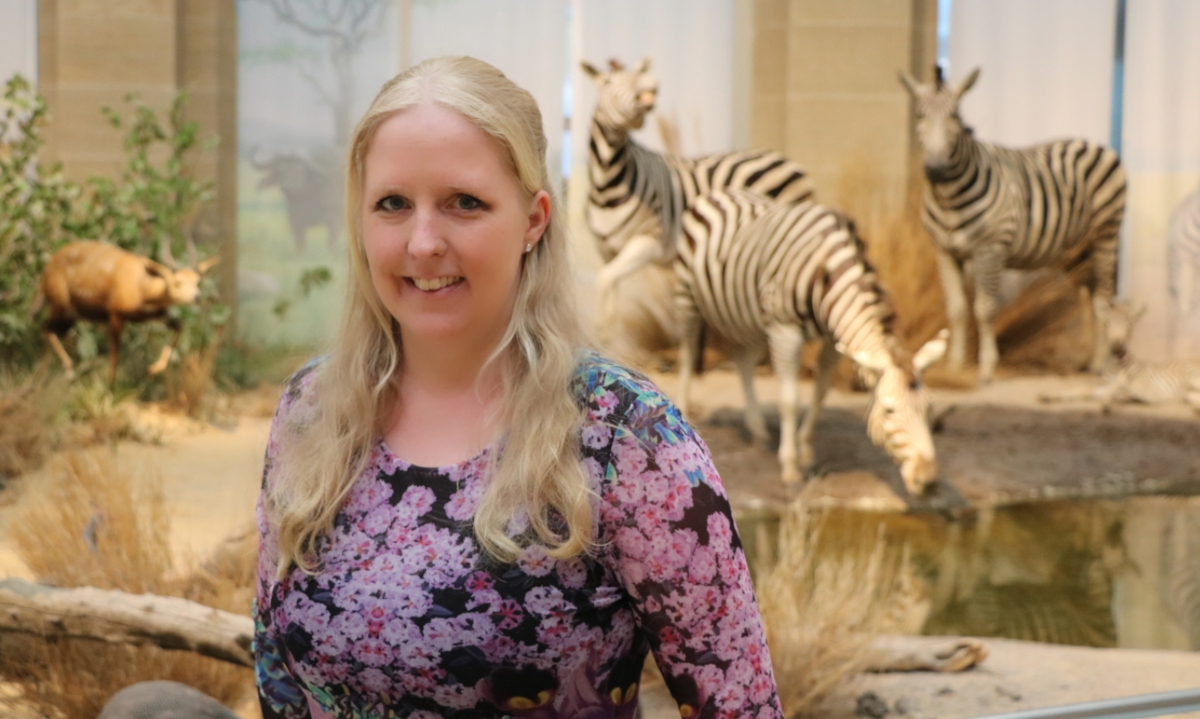Faces of the LIB: Katja Waskow
“Diversity is the ice cream parlour of life”
© Oriana Wojewski-Yelle
She wants to get people excited about nature and species knowledge: Katja Waskow is the coordinator of the project FörTax – Promotion of Taxonomic Knowledge as a Basis for Nature Conservation at LIB. She wants to reach as many people in society as possible with her work and communicate the importance of biodiversity. In the interview, she also reveals how dinos in her grandfather’s garden led her to palaeontology.
What led you to biology? Was there a key experience?
Through palaeontology: As a palaeontologist, I have been studying the classic among extinct creatures – the dinosaurs. Among the reasons for this are the dinos that are still alive today, which used to run and fly through my grandfather’s garden when I was a child: Pigeons. Birds and dinosaurs are closely related and are thus, so to speak, the “modern” dinos in our gardens. My grandfather was a passionate breeder and so it happened that the young pigeons, which could not yet fly, often sat together with me on the lawn. Even though I didn’t have any specific career plans at the time, in retrospect I think this was one of the reasons for my enthusiasm for nature.
Which aspect of your daily work is your highlight?
Learning something new every day, not only in exchange with colleagues, but especially in conversations with people from very different parts of society, when I can bring them closer to the importance of nature and evolution for our lives in the here and now.
What does nature mean to you personally? Where is your favourite place in nature?
A time spent in nature means: switching off, taking a deep breath, recharging your batteries. There is more than one beautiful place for this. But the most important places are definitely those that are right on your doorstep and can therefore be reached every day – for example, a nearby lake or the forest.
Crayfish, fish, butterflies: Who has your very personal affection?
Besides the above mentioned dinos still living today, the birds, my special fascination is life in the water. For this reason, in addition to sauropods, marine reptiles are also part of my field of expertise.
How do you explain the term biodiversity to children/older people?
Quite simply in one word: diversity – diversity of animals, plants, fungi, bacteria as well as habitats and genes. In short: diversity is the ice cream parlour of life.
Which sub-area at the LIB is particularly close to your heart personally?
As expected, the Education Department, including the exhibitions. Only the broad transfer of knowledge into society gives a deeper meaning to the new scientific findings that are obtained at our house. We can contribute to changing people’s thinking and actions for the benefit of nature.
What do you want people to associate with the LIB in ten years’ time?
Enjoyment of life, sustainability, diversity, research and innovation.
How do we get as many people as possible excited about species knowledge and nature conservation?
What you know and love, you also want to protect. So the challenge is first and primarily to get people excited about nature again. This requires above all spaces for contact with nature itself. Above all, we must actively approach the large group of non-visitors, people who do not usually come to our museums. With an emotional connection, the desire to learn about species then arises from the interested people’s own intrinsic drive. In addition, educational offers and expert knowledge are needed to feed the thirst for knowledge that arises. This is precisely where actors in the citizen science sector can play an important role.
What would you have become if biology had not worked out?
Probably make-up artist or veterinarian. At least those were my first intentions after graduating from high school, but I didn’t pursue them.
What advice do you have for young biologists at the beginning of their careers?
Take as much as you can along the way and gain experience where you can. The numerous excavations, field trips, internships, as well as the work in teaching, exhibition design, preparation, museum education and the activities for press and public relations that accompanied me during my studies were valuable experiences that I would not want to miss. I took away a lot from this that is not in books or taught in lectures.
Do you have a dream of what your work might have achieved in five or ten years?
In ten years’ time, together with my FörTax team and the entire LIB, I would like to have contributed to a rethinking of the responsible use of nature in society at large. Political awareness of the immense importance of biodiversity for our own existence is essential for this. Therefore, my declared goal is to continue the work on the FörTax project after the end of the current term – and ideally to expand the project further, also beyond the borders of the LIB.
Dr. Katja Waskow studied geology and palaeontology at the University of Bonn and did her PhD in biology on the rib histology of vertebrates. Her work focused on reconstructing the growth rates and life histories of various sauropod taxa as well as researching marine reptiles. Her involvement in exhibition and public relations work as well as museum education led her to the LIB. Since 2020, she coordinates the FörTax project at the Museum Koenig Bonn, which aims at the broad social communication of species knowledge as a basis for nature conservation. She is also involved within the LIB as a contact person in the area of Citizen Science, as a member of the staff council, the festival committee and the sustainability working group.



